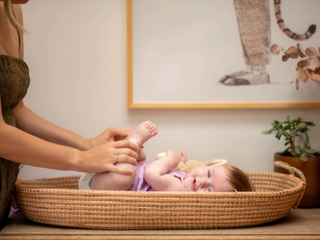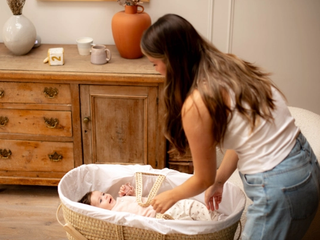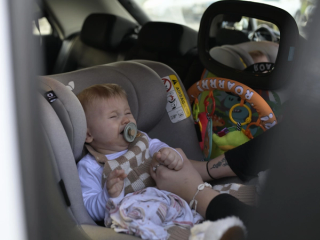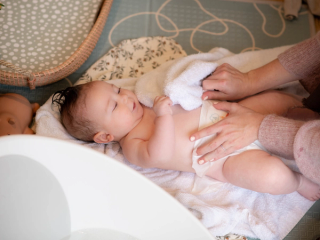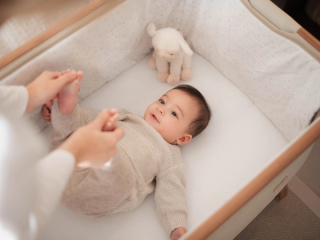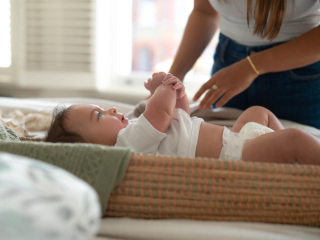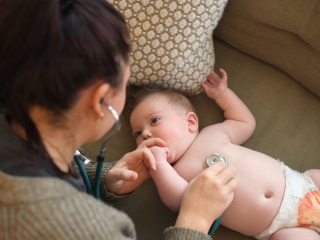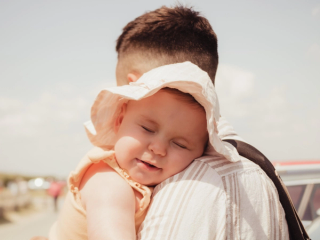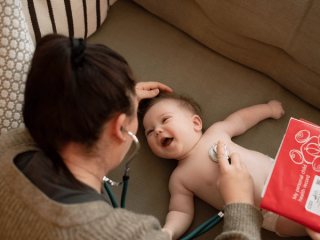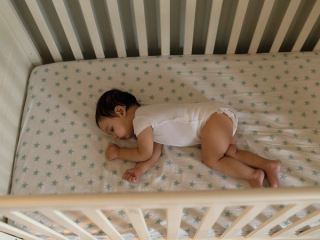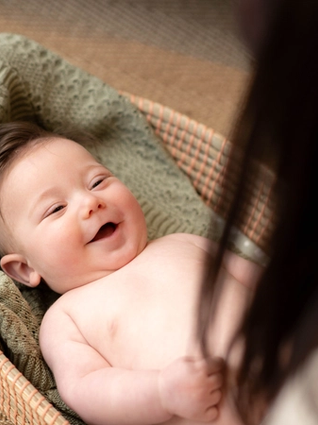
- Home
- Advice Hub
- Newborn
- Essential Newborn Care
- Causes Of An Outie Belly Button In Babies
Outie Belly Buttons in Babies: What Parents Need to Know
Discover what causes an outie belly button in newborns, when it’s a sign of an umbilical hernia or granuloma, and how to care for it safely.
8 min
29/10/2025
When your baby’s umbilical cord falls off, it can be both fascinating and slightly nerve-wracking to see what’s left behind. Many parents expect a neat little “innie” belly button, so when it looks like it’s sticking out, it can cause some worry. The good news is that most “outie” belly buttons are completely harmless and simply part of how your baby’s body has healed.
Let’s explore what causes an outie, how to tell when it’s normal, and when it might need checking by a health professional.
Why do some babies have an outie belly button?
The short answer is that it usually comes down to how your baby’s body heals after the umbilical cord stump falls off. The umbilical cord was your baby’s lifeline during pregnancy, connecting them to the placenta for oxygen and nutrients. After birth, the cord is clamped and cut, leaving a small stump that naturally dries out and drops off within a week or two.
Once it heals, some babies end up with a belly button that goes inward (an “innie”) while others have one that protrudes slightly (an “outie”). This difference has nothing to do with how the cord was cut or how you cared for it, it’s simply how your baby’s body formed and healed.
An outie is usually just a variation in normal anatomy. However, in some babies, what looks like a simple outie may actually be caused by a small umbilical hernia or a tiny overgrowth of healing tissue, known as a granuloma.
What is an outie belly button?
An “outie” belly button is one that sticks outwards rather than dipping inwards. The skin around the belly button may appear raised, rounded, or slightly soft to touch. Some outies flatten over time as your baby grows, while others stay visible into childhood and adulthood.
It’s worth remembering that “outie” isn’t a medical diagnosis, it’s just a description. In most cases, it’s harmless. What matters is that the area looks healthy, clean, and free from redness, swelling, or discharge.
Possible causes of an outie belly button
Although most outies are simply normal variations, there are a few possible reasons why your baby’s belly button might stick out.
Umbilical hernia
This is one of the most common reasons a baby’s belly button protrudes. An umbilical hernia happens when a small gap remains in the abdominal wall where the umbilical cord once passed through. When your baby cries, coughs, or strains, a small bit of intestine or fatty tissue can bulge through this gap, causing the belly button to pop out more noticeably.
Umbilical hernias are common, especially in premature babies and those with lower birth weights. The reassuring part is that they usually close on their own as your baby’s abdominal muscles strengthen. Most heal completely by the age of two to three years.
You might notice the hernia is more visible when your baby is crying or pushing, and flatter when they’re calm. As long as it’s soft, not painful, and not growing rapidly, it’s usually safe to simply keep an eye on it.
Seek medical advice if the hernia becomes firm, discoloured, painful, or your baby seems unwell, these are rare signs of a complication called incarceration, which needs urgent review.
Umbilical granuloma
After the cord stump falls off, some babies develop a small pink or red moist lump at the base of the belly button called a granuloma. This is simply an overgrowth of healing tissue. It may look shiny or weepy and can make the area appear slightly raised.
A granuloma is not an infection and doesn’t hurt your baby. In most cases, your health visitor or GP can advise and it usually heals beautifully once treated.
Normal variation in healing
Sometimes, there’s no hernia or granuloma at all…just a natural difference in how the skin and connective tissue closed. The cut, the way the cord dried, or even how the baby’s tummy muscles sit can influence the final shape.
This type of outie is purely cosmetic and doesn’t indicate any medical problem. It’s simply how your baby’s unique belly button formed, and it doesn’t require treatment.
Other, less common causes
Very rarely, a protruding belly button can be linked to infection or more complex abdominal wall conditions, but these are usually identified soon after birth and managed in hospital.
Signs of infection include redness spreading around the navel, yellow or green discharge, a foul smell, or tenderness. If you notice any of these, seek medical advice promptly.
When to be concerned and when to see a doctor
Most outie belly buttons are harmless, but there are certain signs to look out for. Contact your GP or health visitor if you notice any of the following:
- Persistent bleeding or discharge after the cord has fallen off
- A foul smell or yellow-green fluid from the navel
- Redness spreading around the belly button
- A hernia that becomes hard, swollen, painful, or changes colour
- Rapid increase in size of the bulge
- Your baby seems unwell, has a swollen tummy, or is vomiting
These signs don’t always mean something serious, but they do need checking to rule out infection or complications.
How an outie may change over time
Many parents are surprised to find that an outie can change quite a lot during the first few years. As your baby grows, their abdominal wall strengthens and the tissues naturally pull inwards.
If the cause is a small hernia, it often resolves on its own by around age of 2-3. Doctors rarely recommend surgery unless it persists beyond that age or causes discomfort. If your baby’s outie is simply how their skin healed, it may stay that way into adulthood, which is perfectly fine and just another variation of normal.
It’s very important not to try to push the belly button in, tape it down, or use home remedies. These won’t help the healing process and could actually cause irritation or infection.
Caring for your baby’s belly button
In the early weeks, while the cord stump is still attached or healing, focus on gentle hygiene:
- Keep the area clean and dry. A quick wipe with cooled boiled water on cotton wool is enough.
- Avoid alcohol wipes unless specifically advised.
- Allow the stump to dry naturally - don’t pull it off, even if it’s hanging by a thread.
- Fold nappies down slightly so they don’t rub against the area.
- After baths, gently pat dry the navel instead of rubbing.
Once the stump has fallen off, continue to monitor for any discharge or unusual swelling.
Remember: never apply plasters, coins, or pressure pads to an outie. These old-fashioned remedies don’t work and can make things worse.
Myths and misconceptions
There are plenty of myths about baby belly buttons, and they often make parents worry unnecessarily. Let’s clear a few up:
- “An outie means something is wrong.”
Not true. Most are harmless and part of normal healing. - “You can prevent an outie by how you cut or care for the cord.”
The shape of your baby’s belly button is determined by how their body heals, not by cord care. - “All outies need surgery.”
Only a small number ever do, usually for persistent hernias after age three or four. - “Taping the belly button helps it go in.”
This can irritate the skin and is not recommended.
Frequently Asked Questions around outies
Yes, many newborns have a slightly raised or puffy navel in the early weeks. It often settles as the area heals and the muscles strengthen.
If it’s caused by a small hernia, it often closes naturally by the age of 2-3. If it’s simply how the skin healed, it may remain an outie, which is completely fine.
No, please don’t. It’s not safe and won’t make it go in faster.
Possibly. A soft bulge that gets larger when your baby cries could be a hernia, while a small pink moist lump might be a granuloma. Both are common and usually easy to manage.
If it’s red, painful, leaking, hard, or your baby seems unwell, get it checked. Otherwise, gentle observation is enough.
Most outie belly buttons are simply one of those charming quirks that make your baby unique. They rarely cause problems and often improve with time. Keep the area clean, avoid unnecessary treatments, and enjoy watching your baby grow.
If you’re ever unsure or would like tailored reassurance, you can always speak with your health visitor, GP, or pharmacist.
As a private health visitor, I also support families one-to-one through Essential Parenting, offering calm, evidence-based advice on everything from newborn care to sleep, feeding, and development. You can find out more or book a consultation at Essential Parenting.
